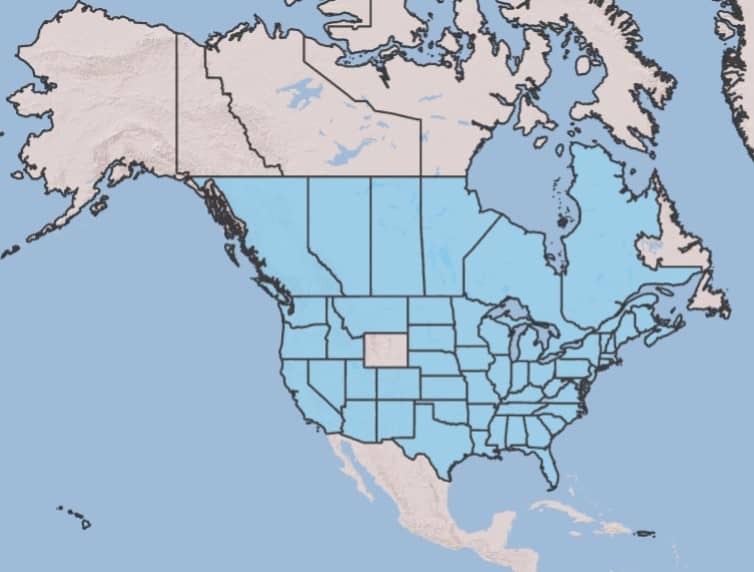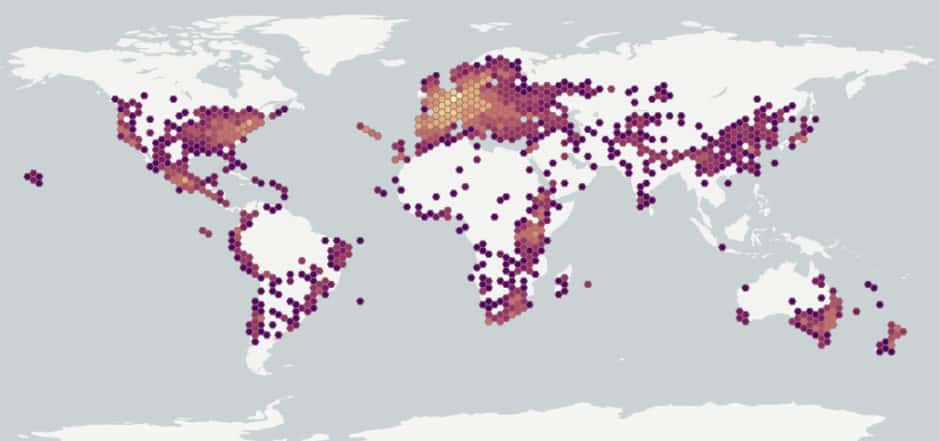Datura stramonium
Overview
Aperçu
Regulation :
Remarques Réglementation:
- CFIA Weed Seeds Order - Class 2: Primary Noxious Weed Seeds
- USA Federal Noxious Weed Seed List
Regulation Notes:
Distribution :
Répartition :
Native range thought to be tropical Central and South America, now present in Asia, Africa, North and South America, Europe, Australia and New Zealand (CABI 2022). It occurs across Canada except for in Nova Scotia, Newfoundland, Nunavut, Yukon and Northwest Territories (Brouillet et al. 2010+).
Habitat and Crop Association :
Habitat et Cultures Associées :
Found in cultivated fields, row crops, old fields, gardens, farmyards, fencelines, shores, roads and disturbed areas (Weaver and Warwick 1984; Darbyshire 2003). A weed of Sorghum bicolor subsp. bicolor (sorghum), Glycine max (soybeans), Phaseolus vulgaris (beans), Zea mays (corn), Nicotiana tabacum (tobacco), Solanum lycopersicum (tomatoes), Carthamus lanatus (safflower) and Capsicum annuum (sweet peppers) (Weaver and Warwick 1984; CABI 2022).
Economic Use, cultivation area, and Weed Association :
Utilisation économique, zone de culture et association de mauvaises herbes :
Duration of Life Cycle :
Durée du cycle vital:
Annual
Dispersal Unit Type :
Type d’unité de dispersion :
Seed
General Information
RENSEIGNEMENTS GÉNÉRAUX
Datura stramonium is an aggressive colonizer of agricultural fields in almost any summer crop. Plants can produce up to 30,000 seeds in ideal conditions, dispersed by harvest machinery, water and as a contaminant of seed (Weaver and Warwick 1984). Seeds generally germinate when mature, but can become dormant, and were found to be viable after 39 years in the soil (Weaver and Warwick 1984). D. stramonium produces alkaloids that can be fatally poisonous to livestock and humans (Weaver and Warwick 1984).
D. stramonium was reported as a weed of gardens, waste places and farmyards in Canada from 1821 onwards, and became a weed of cultivated fields only in the 1950s (Weaver and Warwick 1984).
.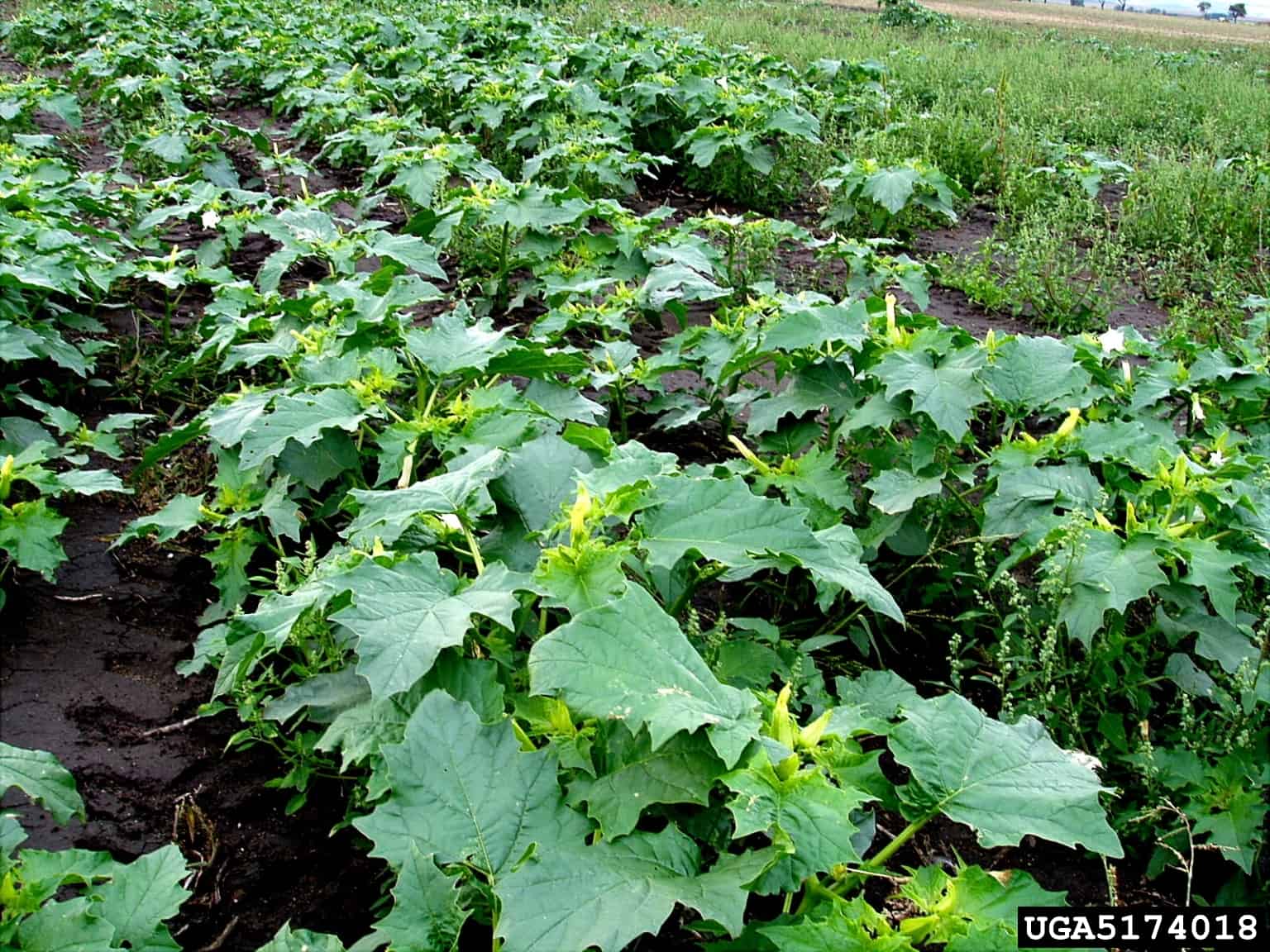
Datura stramonium infestation (Jan Samanek, Phytosanitary Administration, Bugwood.org)
Identification
Identification
-
Capsule
Size
- Capsule length: 30.0 – 70.0 mm; width: 20.0 – 50.0 mm (Weaver and Warwick 1984)
Shape
- Capsule is oval or egg-shaped
Surface Texture
- Capsule is generally densely spiny, but smooth capsules can occur (Weaver and Warwick 1984)
Colour
- Mature capsule is straw-yellow, immature capsule is green
Other Features
- Capsule opens by 4 valves (Weaver and Warwick 1984)
-
Seed
Size
- Seed length*: 2.9 – 4.2 mm; width: 2.3 – 3.6 mm
*Note: minimum and maximum of 10 seeds in a normal range of this species using image measurement (ISMA 2020)
Shape
- D-shaped to slightly kidney-shaped seed, compressed in edge view
Surface Texture
- Seed surface wrinkled and densely pitted
Colour
- Seed dull or shiny black or dark brown
- Immature seeds are light brown or straw yellow, may have black patches or mottles
Other Features
Hilum and Hilum area
- The hilum is generally triangular with straight edges along the compressed side edge of the seed
- Hilum is filled with white or pinkish tissue
- Seeds generally have a bump below one end of the hilum
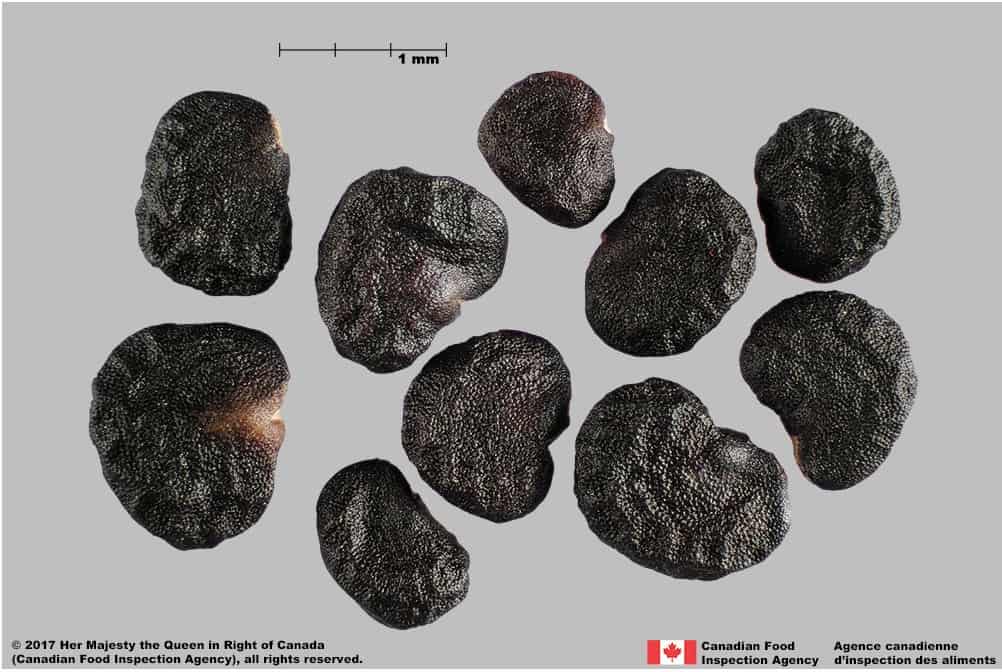
Jimsonweed (Datura stramonium) seeds

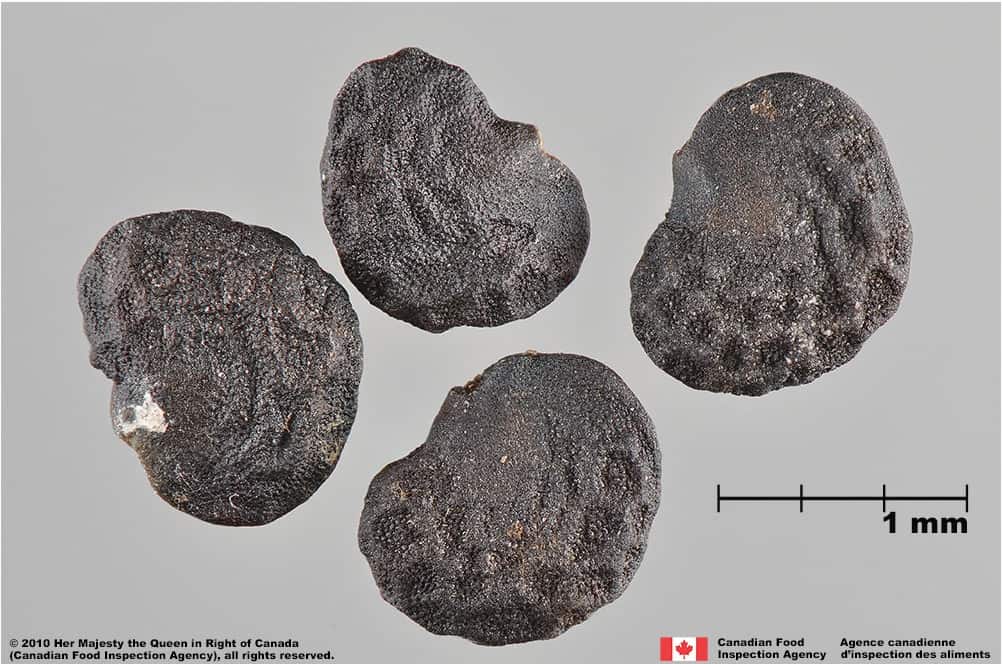
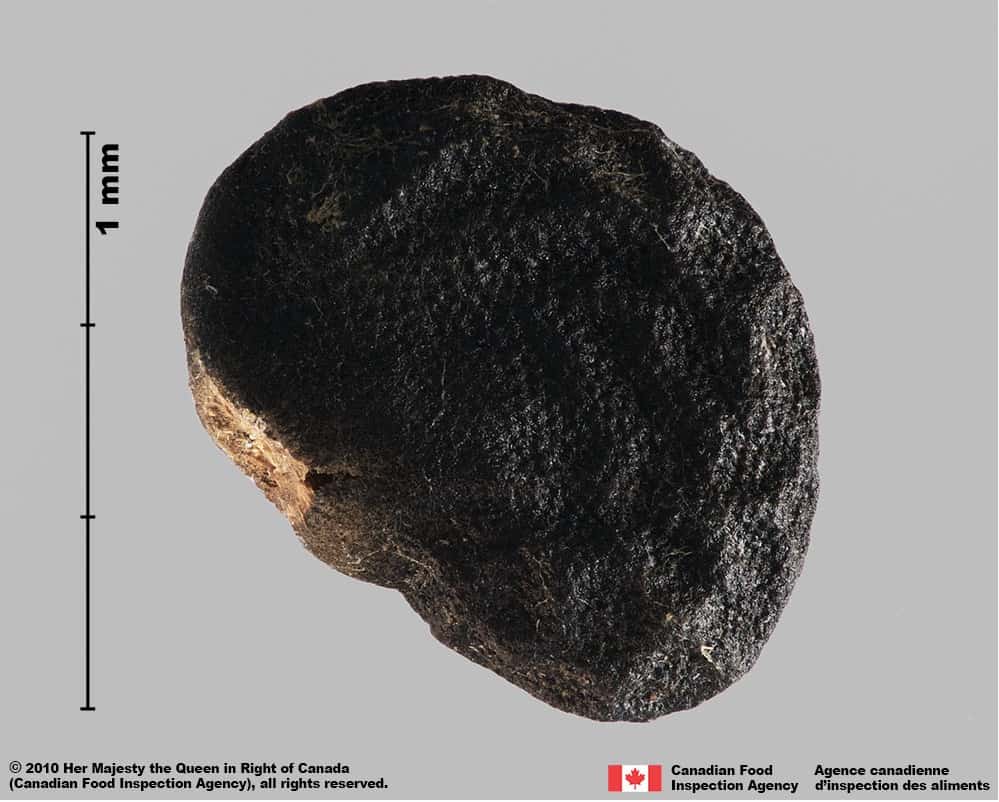
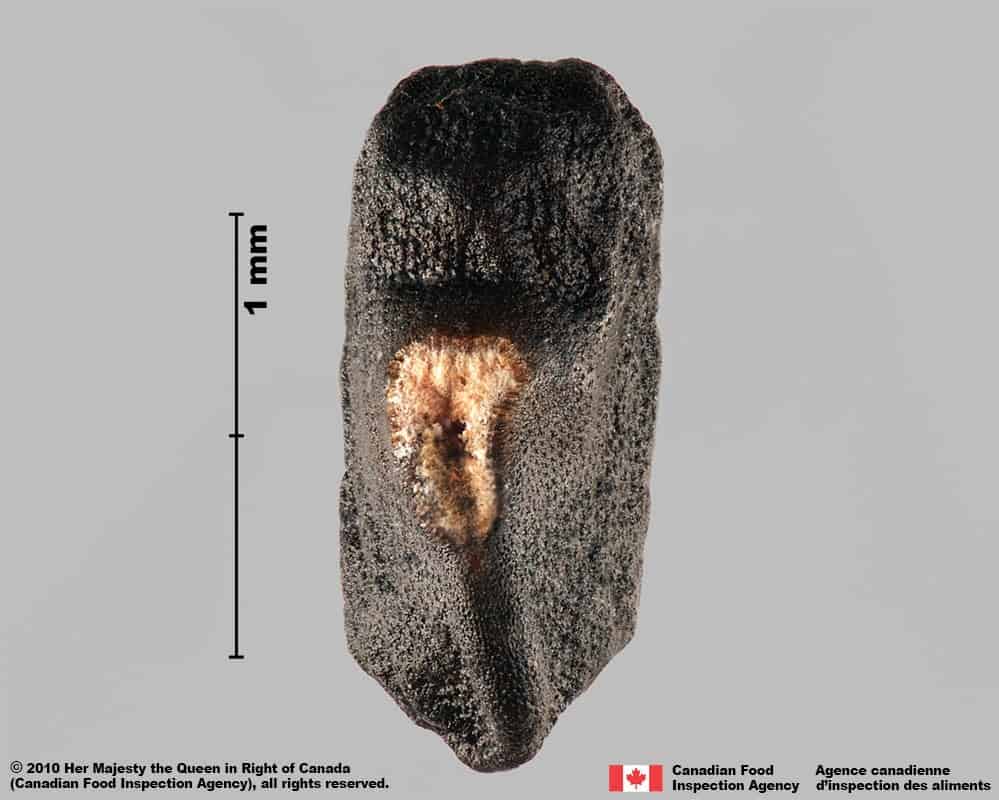
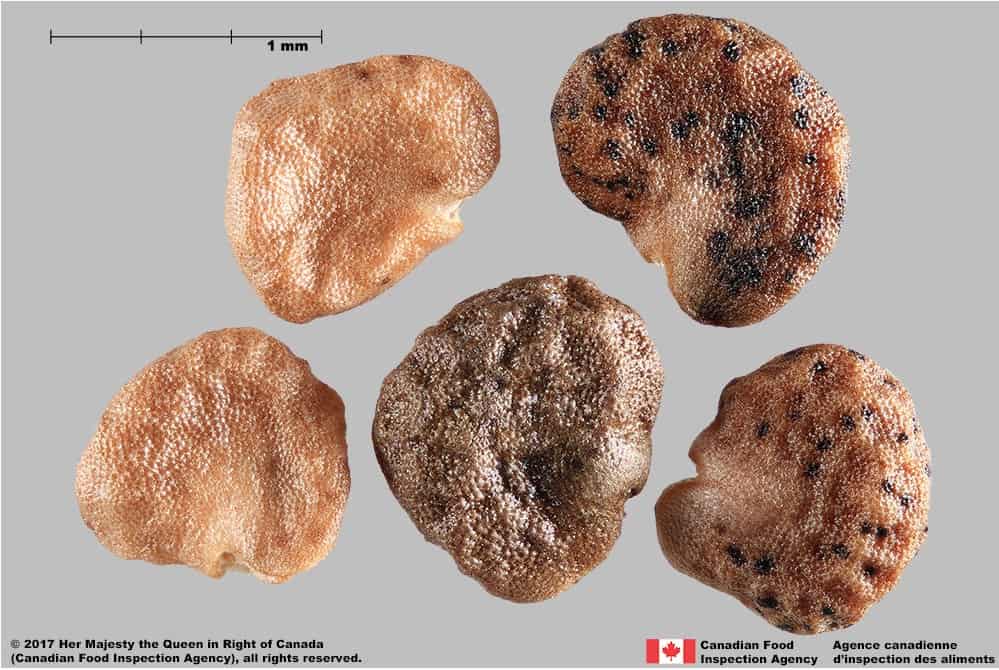
-
Embryo
Size
- Embryo partially fills the seed
Shape
- Embryo is circular
Endosperm
- Endosperm is soft and translucent white
Other Features
- Embryo is in a peripheral position in the seed
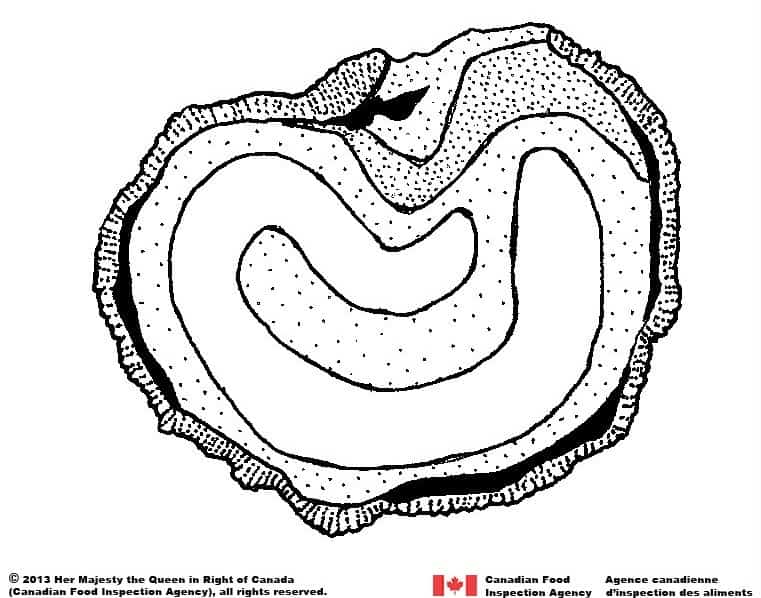
Jimsonweed (Datura stramonium) seed, cross-section

Identification Tips
CONSEILS POUR L’IDENTIFICATION
The D-shaped, compressed in edge view, seed of Datura stramonium has a common shape among species of the Solanaceae. Only a few Solanaceae species with D-shaped seed are also black or dark brown in colour, e.g., Datura ferox, Datura stramonium and Solanum rostratum.
Seeds of Datura species can be distinguished from similar species by a shallowly-pitted seed coat and a hilum filled with whitish tissue. The shape of the hilum and hilum area are then used to distinguish between species of black-seeded Datura. A triangular hilum and raised hilum area are the identifying features of D. stramonium.

Jimsonweed (Datura stramonium) seeds





Additional Botany Information
AUTRES RENSEIGNEMENTS BOTANIQUES
Flowers/Inflorescence
- Flower length: 5.0 – 10.0 cm (CABI 2022)
- White or purplish flowers are tubular or trumpet-shaped (CABI 2022)
Vegetative Features
- Leaves arranged alternately and if crushed have foul odor (CABI 2022)
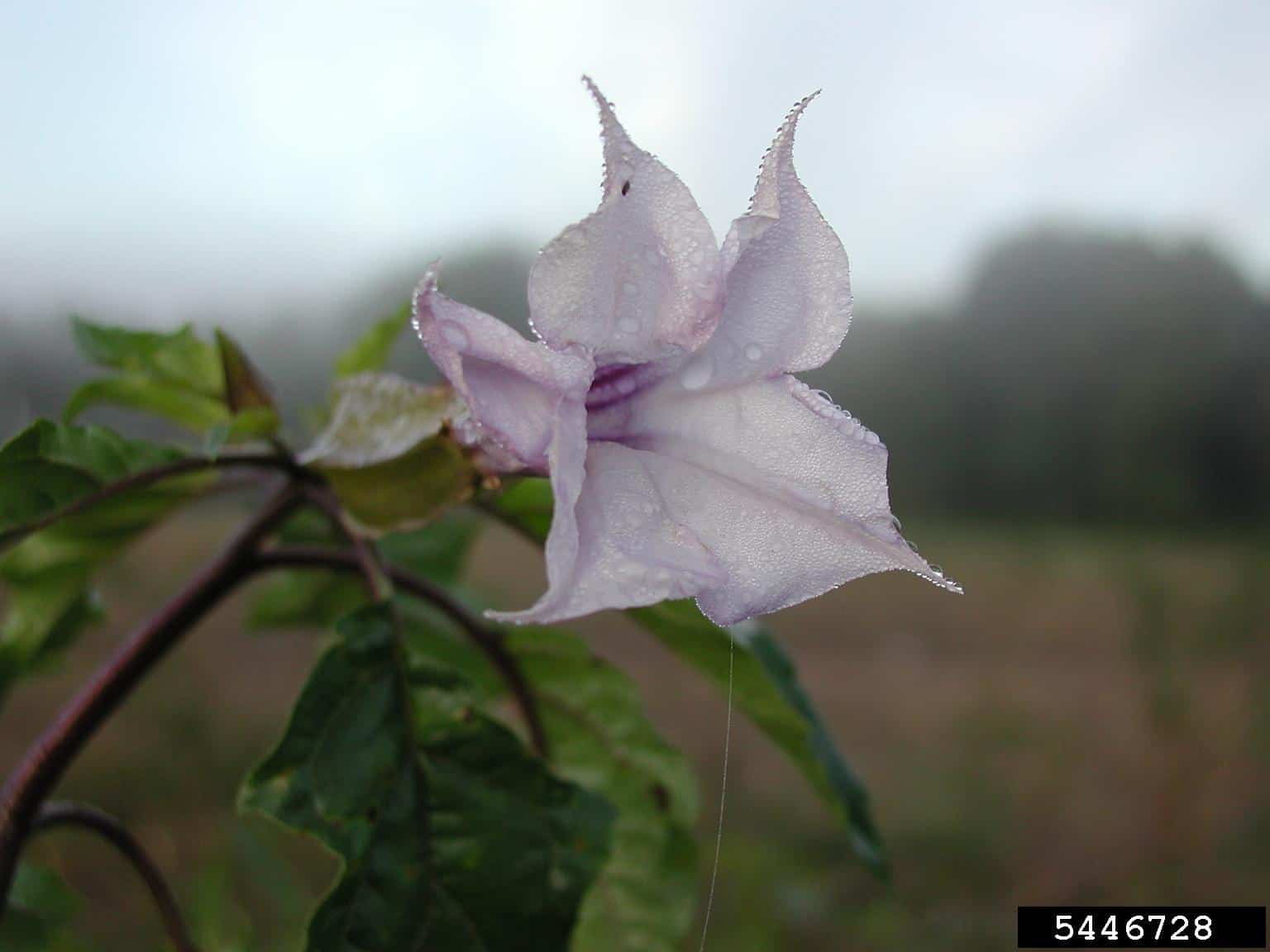
Datura stramonium flower (Leslie J. Mehrhoff, University of Connecticut, Bugwood.org)

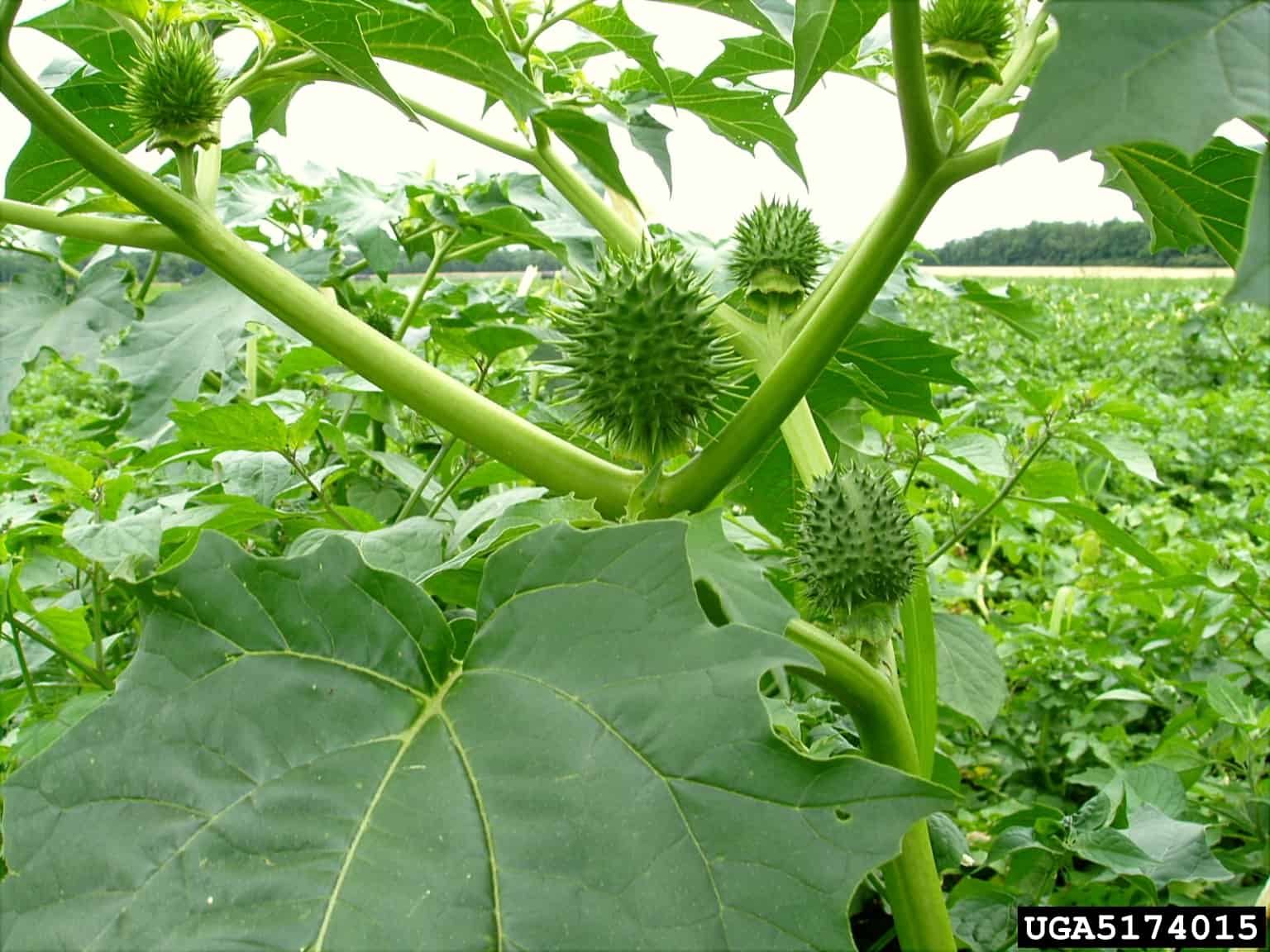
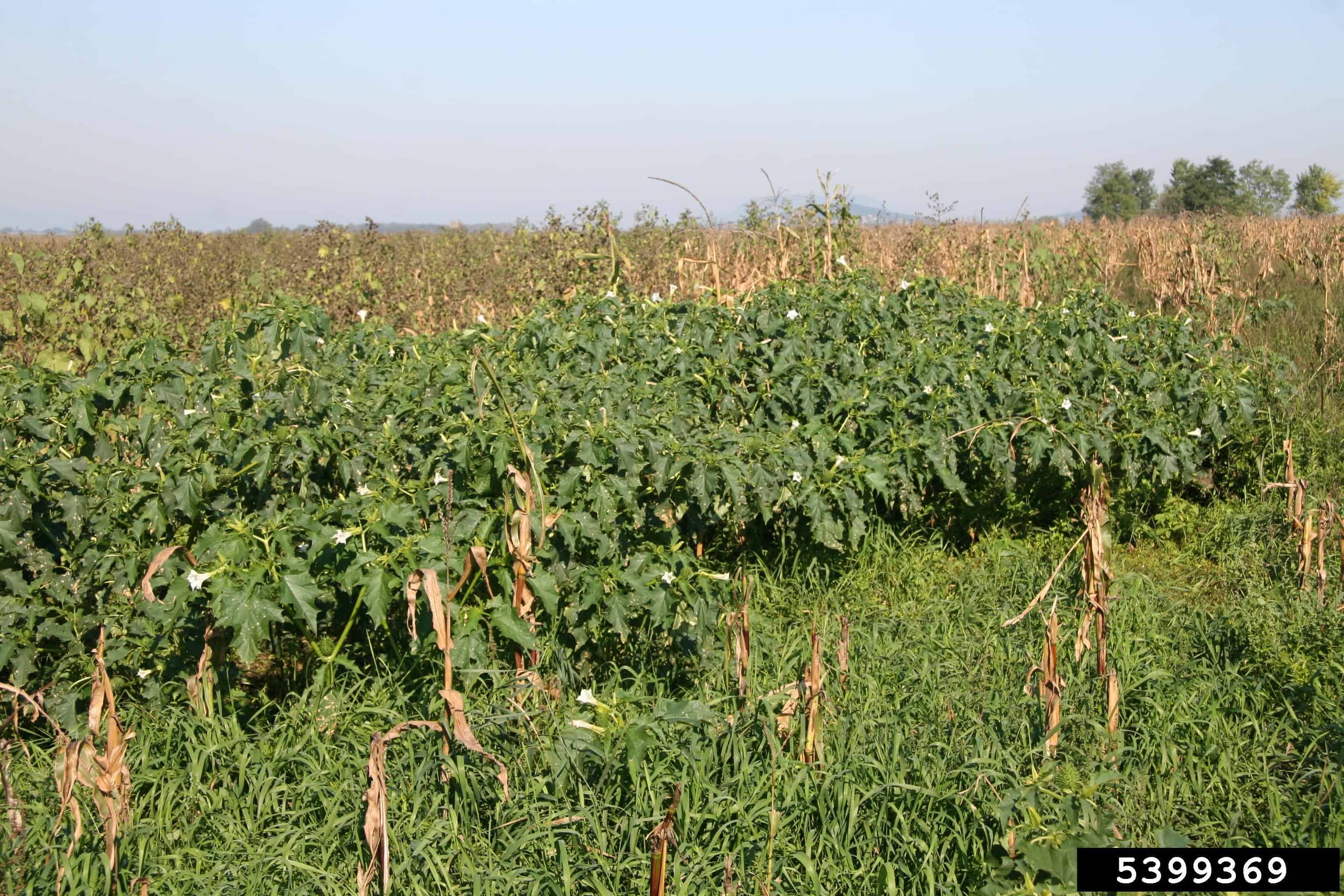
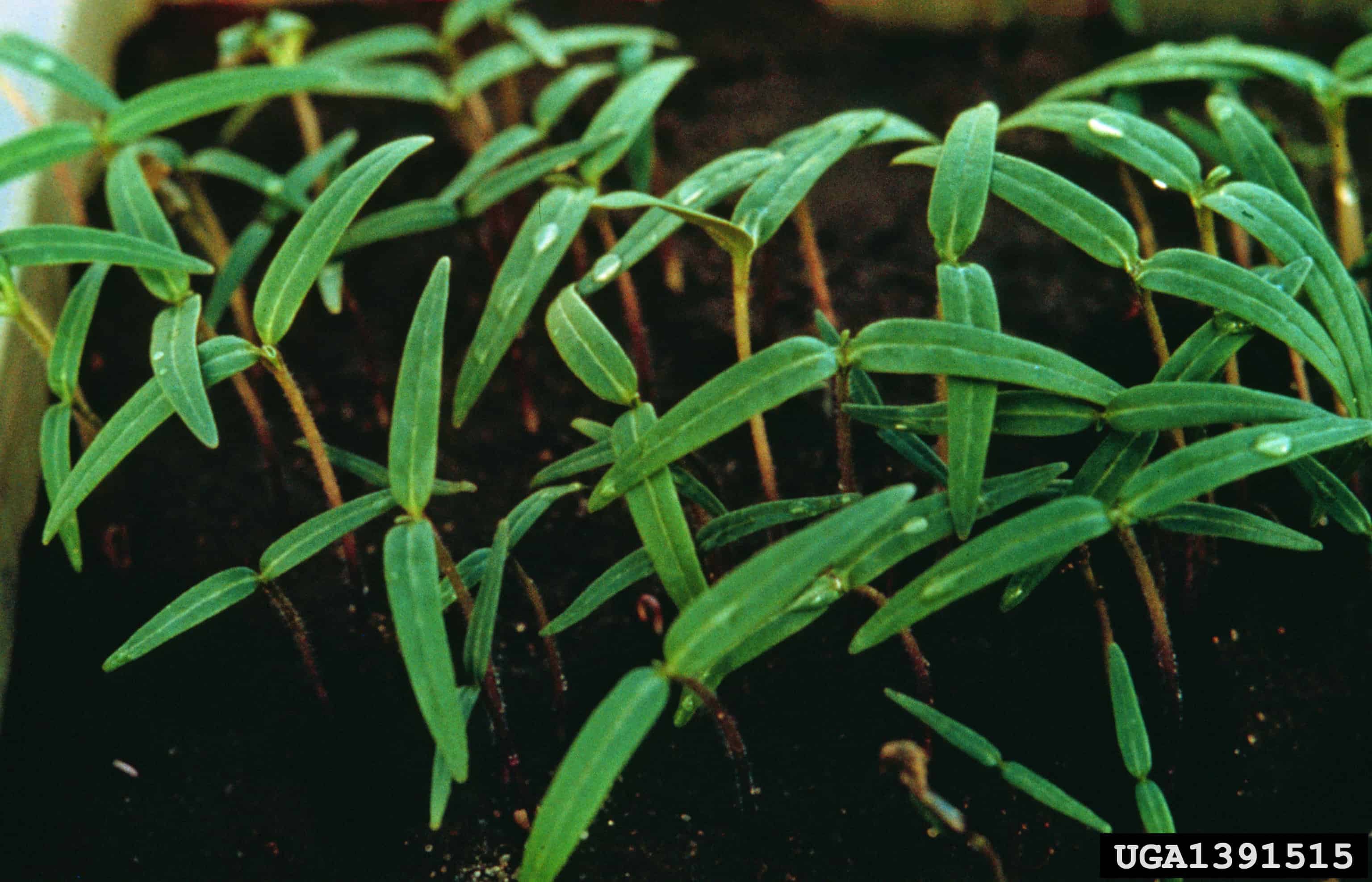
Similar Species
ESPÈCES SEMBLABLES
Similar species are based on a study of seed morphology of various species, and those with similar dispersal units are identified. The study is limited by physical specimen and literature availability at the time of examination, and possibly impacted by the subjectivity of the authors based on their knowledge and experience. Providing similar species information for seed identification is to make users aware of similarities that could possibly result in misidentification.
Solanum rostratum Dunal (buffalobur)
S. rostratum seeds are generally smaller (length*: 1.7 – 2.1 mm; width: 1.3 – 1.7 mm) than D. stramonium, have a deeply pitted surface, wavy edges, and a round hilum without tissue inside.
*Note: minimum and maximum of 20 seeds in a normal range of this species using image measurement (ISMA 2020)
Datura ferox L. (large thorn apple)
The seeds of D. ferox are a generally smaller (length*: 2.9 – 3.4 mm; width: 2.3 – 2.9) than D. stramonium, although there is some overlap. The hilum of D. ferox is generally oval shaped with rounded edges without a bump below, compared to the triangular hilum with a bump below in D. stramonium.
* Note: minimum and maximum of 10 seeds in a normal range of this species using image measurement (ISMA 2020)
Click to select species
Cliquez pour sélectionner les espèces
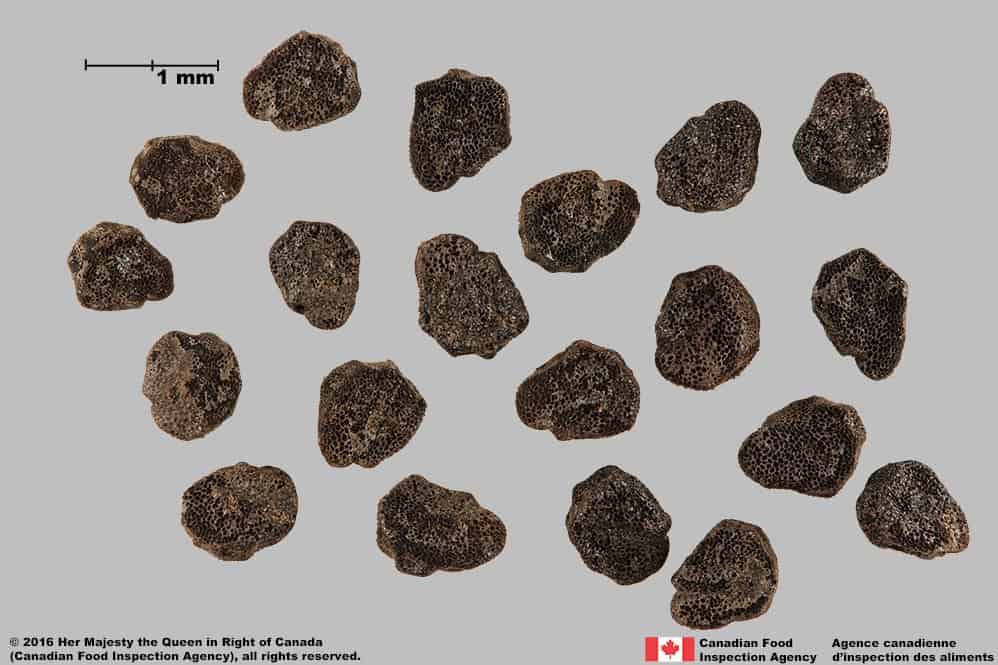
Solanum rostratum
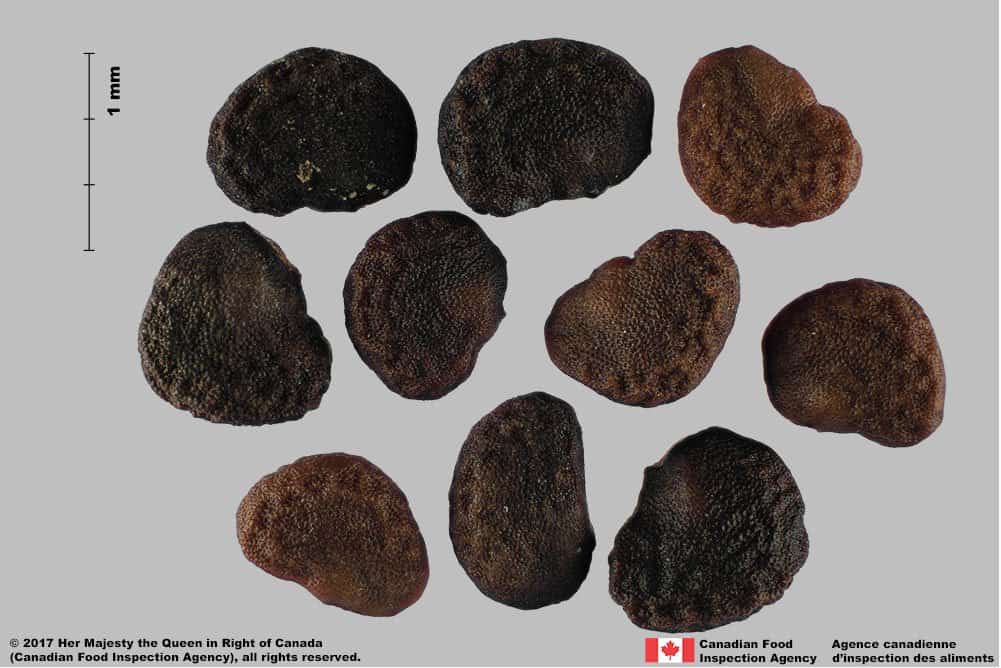
Datura ferox
Comparison Window
Fenêtre de comparaison
MAIN SPECIES
ESPÈCES PRINCIPALES
Datura stramonium

Datura stramonium
Solanaceae
Jimsonweed (Datura stramonium) seeds
MAIN SPECIES
ESPÈCES PRINCIPALES
Datura stramonium

Datura stramonium
Solanaceae
Jimsonweed (Datura stramonium) seeds
MAIN SPECIES
ESPÈCES PRINCIPALES
Datura stramonium

Datura stramonium
Solanaceae
Jimsonweed (Datura stramonium) seed
MAIN SPECIES
ESPÈCES PRINCIPALES
Datura stramonium

Datura stramonium
Solanaceae
Jimsonweed (Datura stramonium) seed, hilum view
MAIN SPECIES
ESPÈCES PRINCIPALES
Datura stramonium

Datura stramonium
Solanaceae
Datura stramonium (jimsonweed) seeds (immature)
MAIN SPECIES
ESPÈCES PRINCIPALES
Datura stramonium

Datura stramonium
Solanaceae
Jimsonweed (Datura stramonium) seed, cross-section
SIMILAR SPECIES
ESPÈCES SEMBLABLES
Solanum rostratum

Solanum rostratum
Solanaceae
Buffalo bur (Solanum rostratum) seeds
SIMILAR SPECIES
ESPÈCES SEMBLABLES
Solanum rostratum
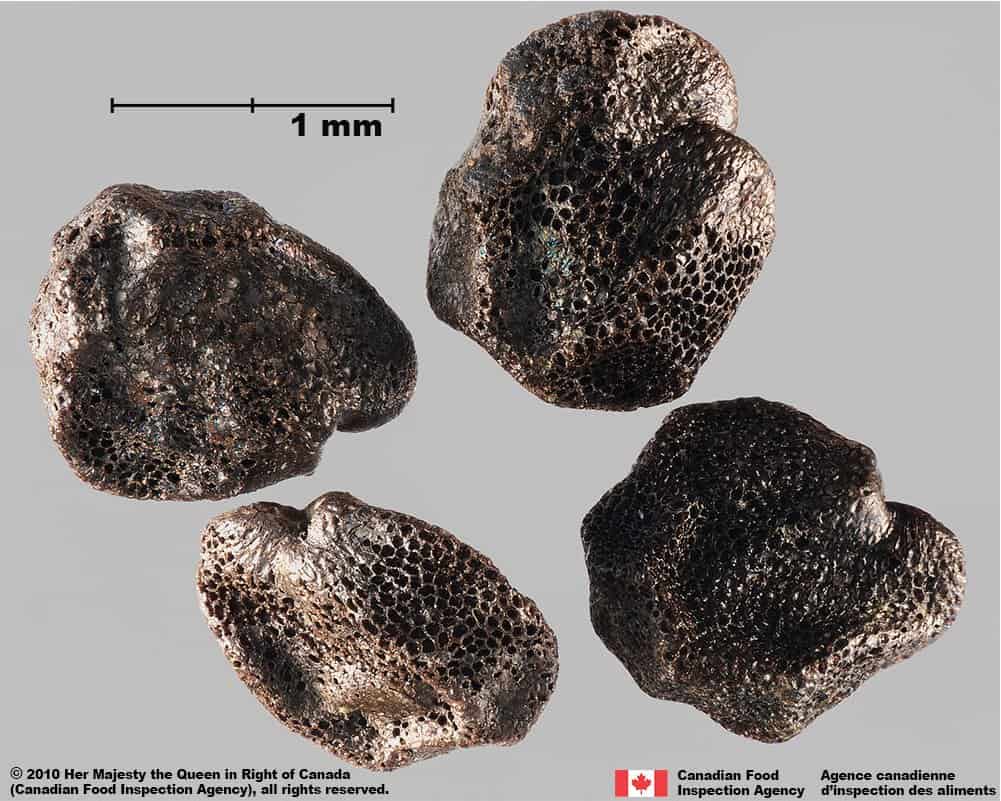
Solanum rostratum
Solanaceae
Buffalo bur (Solanum rostratum) seeds
SIMILAR SPECIES
ESPÈCES SEMBLABLES
Solanum rostratum
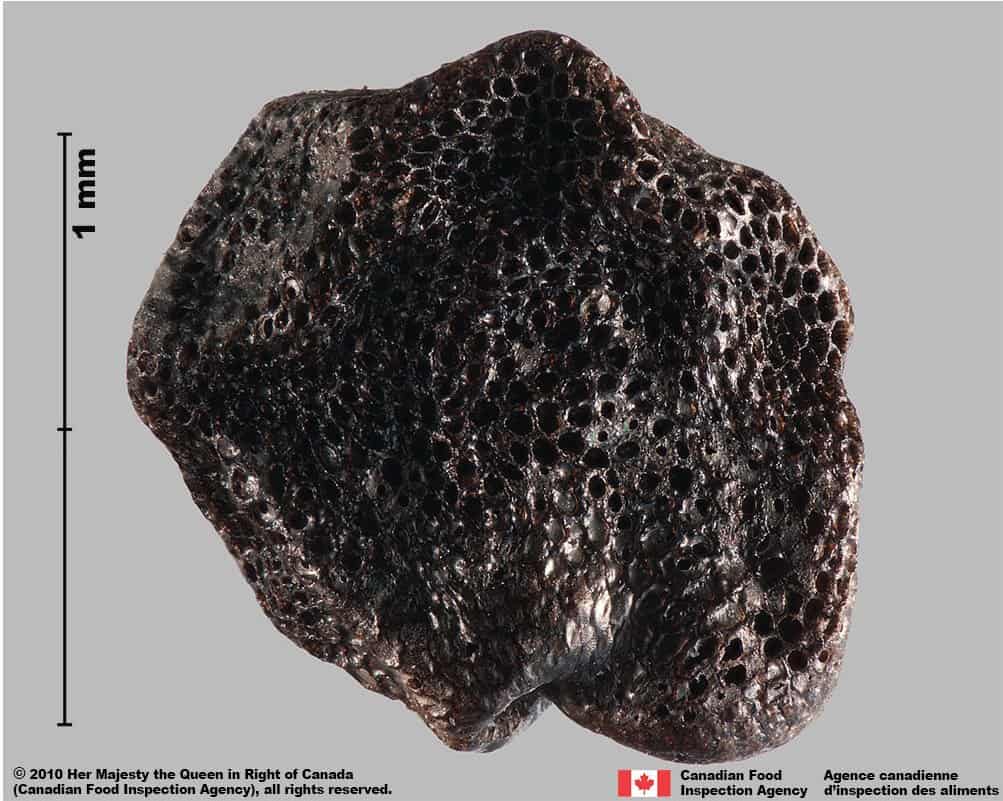
Solanum rostratum
Solanaceae
Buffalo bur (Solanum rostratum) seed
SIMILAR SPECIES
ESPÈCES SEMBLABLES
Solanum rostratum
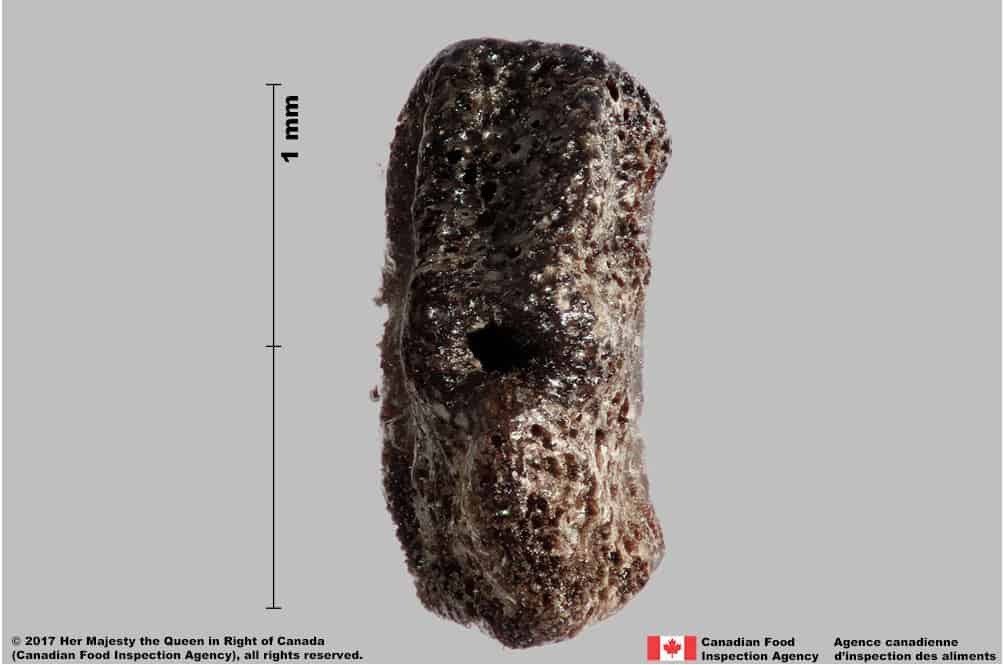
Solanum rostratum
Solanaceae
Buffalo bur (Solanum rostratum) seed, hilum view
SIMILAR SPECIES
ESPÈCES SEMBLABLES
Solanum rostratum
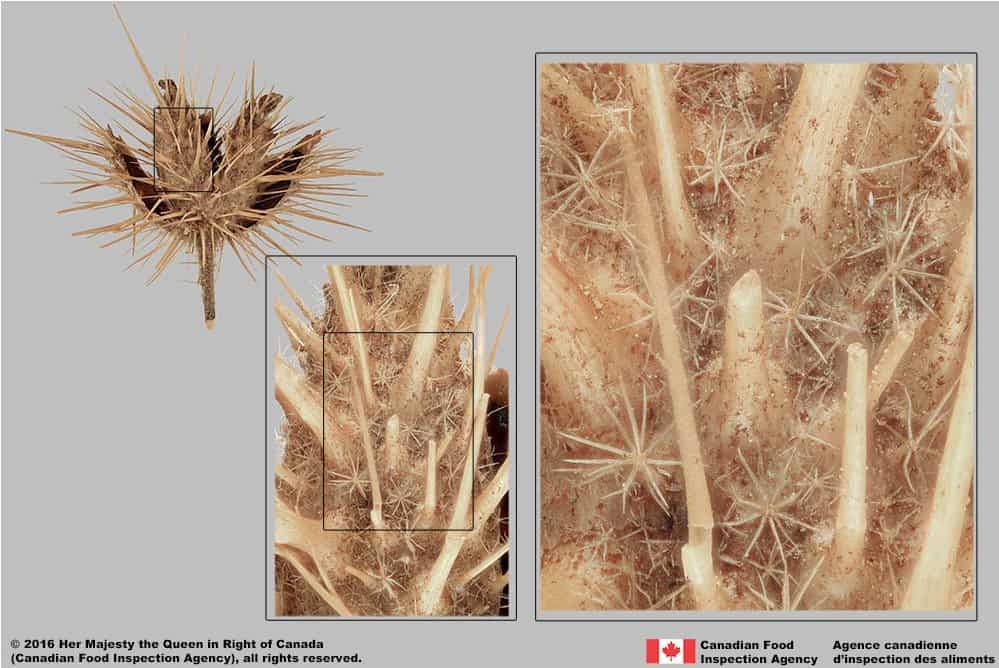
Solanum rostratum
Solanaceae
Buffalo bur (Solanum rostratum) berry
Need ID Help?
Besoin d’aide pour l’identification?
Reference(s)
Référence(s)
Brouillet, L., Coursol, F., Meades, S. J., Favreau, M., Anions, M., Bélisle, P. and Desmet, P. 2010+. VASCAN, the database of vascular plants of Canada. http://data.canadensys.net/vascan/ Accessed March 03, 2022.
Centre for Agriculture and Bioscience International (CABI). 2022. Invasive Species Compendium, CAB International, Wallingford, UK. https://www.cabidigitallibrary.org/journal/cabicompendium Accessed March 03, 2022.
Darbyshire, S. J. 2003. Inventory of Canadian Agricultural Weeds. Agriculture and Agri-Food Canada, Research Branch. Ottawa, ON.
Global Biodiversity Information Facility (GBIF) Secretariat. 2022. https://doi.org/10.15468/39omei Accessed via https://www.gbif.org/species/2928751 Accessed December 29, 2022.
Government of Canada (GC). 2016. Canadian Weed Seeds Order. https://laws-lois.justice.gc.ca/eng/regulations/SOR-2016-93/page-2.html (English) https://laws-lois.justice.gc.ca/fra/reglements/DORS-2016-93/page-2.html (French)
International Seed Morphology Association (ISMA). 2020. Method for Seed Size Measurement. Version 1.0. ISMA Publication Guide. https://www.idseed.org/authors/details/method_for_seed_size_measurement.html
U.S. Department of Agriculture-Agricultural Research Services (USDA-ARS). 2022. Germplasm Resources Information Network (GRIN), https://npgsweb.ars-grin.gov/gringlobal/taxon/taxonomysimple.aspx Accessed March 03, 2022.
U.S. Department of Agriculture-Natural Resources Conservation Service (USDA-NRCS). 2022. The PLANTS Database. National Plant Data Team, Greensboro, NC USA. http://plants.usda.gov Accessed December 29, 2022.
Weaver, S. E. and Warwick, S. I. 1984. The biology of Canadian weeds. 6. Datura stramonium L. Canadian Journal of Plant Science 64 (4): 979-991.



